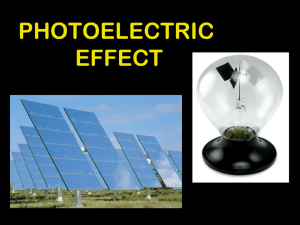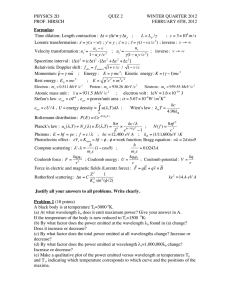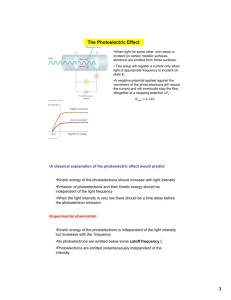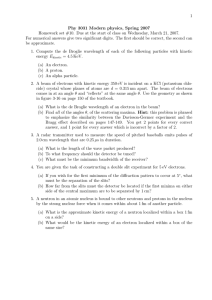Notes 22
advertisement
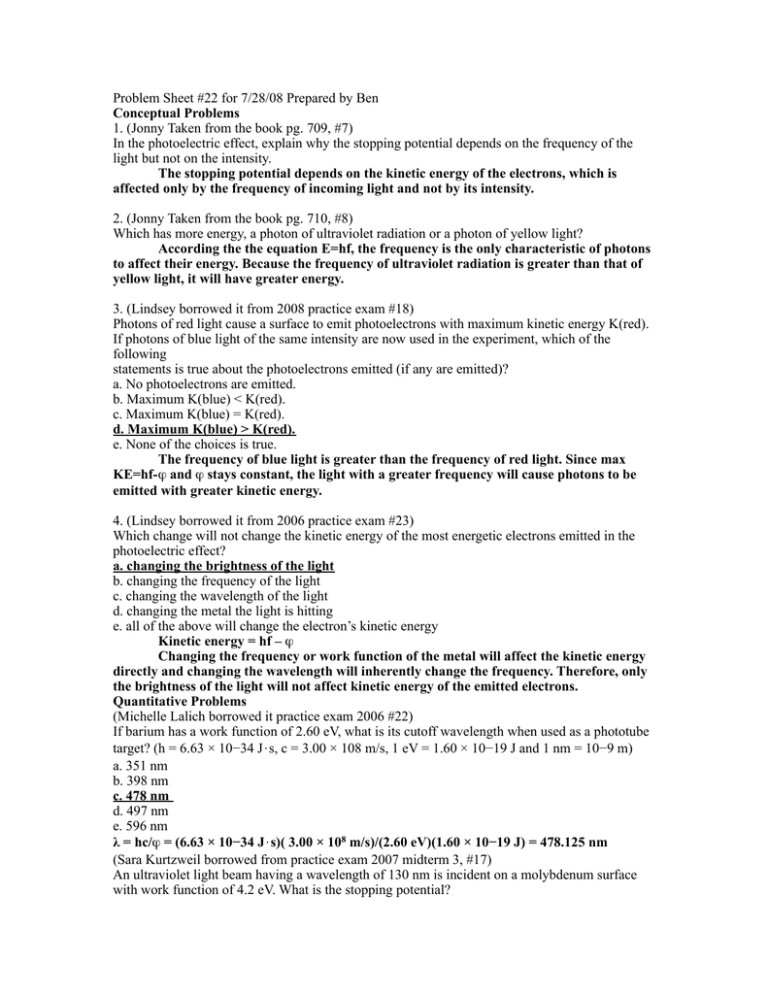
Problem Sheet #22 for 7/28/08 Prepared by Ben Conceptual Problems 1. (Jonny Taken from the book pg. 709, #7) In the photoelectric effect, explain why the stopping potential depends on the frequency of the light but not on the intensity. The stopping potential depends on the kinetic energy of the electrons, which is affected only by the frequency of incoming light and not by its intensity. 2. (Jonny Taken from the book pg. 710, #8) Which has more energy, a photon of ultraviolet radiation or a photon of yellow light? According the the equation E=hf, the frequency is the only characteristic of photons to affect their energy. Because the frequency of ultraviolet radiation is greater than that of yellow light, it will have greater energy. 3. (Lindsey borrowed it from 2008 practice exam #18) Photons of red light cause a surface to emit photoelectrons with maximum kinetic energy K(red). If photons of blue light of the same intensity are now used in the experiment, which of the following statements is true about the photoelectrons emitted (if any are emitted)? a. No photoelectrons are emitted. b. Maximum K(blue) < K(red). c. Maximum K(blue) = K(red). d. Maximum K(blue) > K(red). e. None of the choices is true. The frequency of blue light is greater than the frequency of red light. Since max KE=hf- ϕ and ϕ stays constant, the light with a greater frequency will cause photons to be emitted with greater kinetic energy. 4. (Lindsey borrowed it from 2006 practice exam #23) Which change will not change the kinetic energy of the most energetic electrons emitted in the photoelectric effect? a. changing the brightness of the light b. changing the frequency of the light c. changing the wavelength of the light d. changing the metal the light is hitting e. all of the above will change the electron’s kinetic energy Kinetic energy = hf – ϕ Changing the frequency or work function of the metal will affect the kinetic energy directly and changing the wavelength will inherently change the frequency. Therefore, only the brightness of the light will not affect kinetic energy of the emitted electrons. Quantitative Problems (Michelle Lalich borrowed it practice exam 2006 #22) If barium has a work function of 2.60 eV, what is its cutoff wavelength when used as a phototube target? (h = 6.63 × 10−34 J⋅s, c = 3.00 × 108 m/s, 1 eV = 1.60 × 10−19 J and 1 nm = 10−9 m) a. 351 nm b. 398 nm c. 478 nm d. 497 nm e. 596 nm λ = hc/ϕ = (6.63 × 10−34 J⋅s)( 3.00 × 108 m/s)/(2.60 eV)(1.60 × 10−19 J) = 478.125 nm (Sara Kurtzweil borrowed from practice exam 2007 midterm 3, #17) An ultraviolet light beam having a wavelength of 130 nm is incident on a molybdenum surface with work function of 4.2 eV. What is the stopping potential? (h = 6.63 × 10−34 J⋅s, c = 3.00 × 108 m/s, 1 eV = 1.6 × 10−19 J, and 1 nm = 10−9 m) a. 1.3 V b. 3.5 V c. 5.4 V d. 11.9 V e. 13.6 V The equation f=c/ λ can be used to solve for the frequency. f=3.0x108/1.3x10-7=2.3x1015. This frequency can then be used to solve for max KE, because KE=hf – ϕ. KE=(6.63 × 10-34 J⋅s)(2.3x1015)- 4.2 eV(1.6x10-19)=8.529x10-19 Dividing by e (1.6x10-19) to solve for ΔVs gives 5.4 V Extra problem UV light is incident on a metal surface w/ϕ=3.44eV. The light intensity is 5.5x10-2 w/m2. The emitted photoelectrons have a Vmax = 4.2x105 m/s. How many electrons are emitted per cm2? Assume absorption of every photon emits an electron. ϕ+KEelectron gives the amount of energy needed to knock off 1 electron with the stated velocity. Since the energy in must equal energy out and KE=½mv2, the light intensity divided by ϕ+ ½mv2 will give the number of electrons emitted. Compton effect When light is reflected off a metal, a tiny shift in the wavelength of light is observed. This shift can be explained by viewing light as a particle. Conservation of momentum can explain why the wavelength shifts. Pinitial = Pfinal hc/λ=hc/λ' + Pemitted electron Δ λ=(h/melectron*c)(1-cos θ)
